
DARD-D8H.jpgThis is a 1965, Powershift, 46A Series Caterpillar D8H, pulling a logging arch. This tractor is in excellent condition, and the deep rumble of that big 6 cylinder, slow revving (1250 RPM) Cat engine, is music to any old Cat aficionados ears. |

DARD-Stuss-D6-scoop.jpg"Stuss" Eatts in action with his late 1930's, Cat D6 and "Britstand" scoop. Note the rope control for dumping the load. |
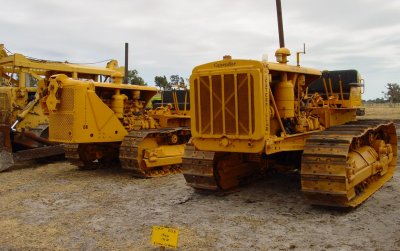
DARD-D8-1H.jpgTwo, 1H-series D8's from the WW2 era. The one to the left has had a fancy "hardnose" installed, so it could carry a cable blade without needing the overhead framework, that was usually used for blade lift mechanisms on Cats in this era. The one on the right is being erroneously described as a 1944, "RD-8". The year of build may be correct, but the last "RD-8" was built around August-Sept 1937. From that date on, they were merely known as the Caterpillar "D8". |
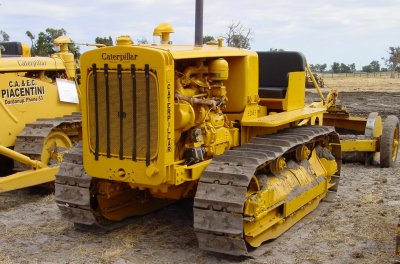
DARD-Stuss-D6.jpg"Stuss" Eatts, late 1930's, 2H series, D6, coupled to a "Britstand" scoop or "fresno". This tractor was purchased in many dis-assembled pieces, and the engine was unrepairable due to corrosion. "Stuss" imported a good used engine from Ohio in the U.S. to Western Australia to repower the D6. He has done a very good restoration job. |
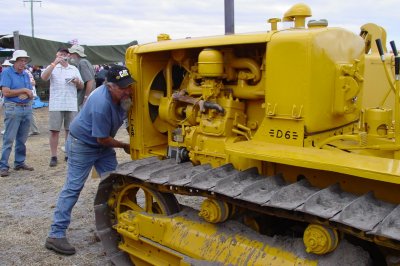
DARD-Stuss-Cranking.jpg"Stuss" Eatts cranking the starting engine into life on his late 1930's, 2H series, 3 cylinder D6. I must admit I was rather surprised at the massive firing stroke thumps on this old 5¾" bore x 8" stroke engine. It vibrated the sandy ground, running at a fast idle. These old Cat engines only do 850RPM at full speed. |
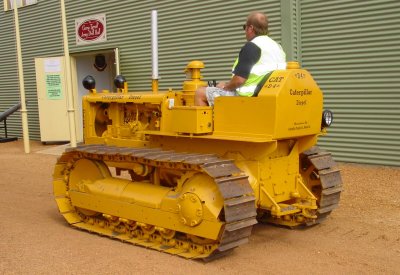
DARD-D4-7U.jpgA very nice little 7U series, Caterpillar D4, being put away at the end of the show day. |

DARD-TD9-LeTourneau-D.jpgA very neat little IH TD-9 crawler, fitted with an Armstrong-Holland double drum cable control and A-H cable blade mechanism. The blade is not fitted. The TD-9 is coupled to a WW2 Model "D" LeTourneau Carryall, which is in excellent condition. |
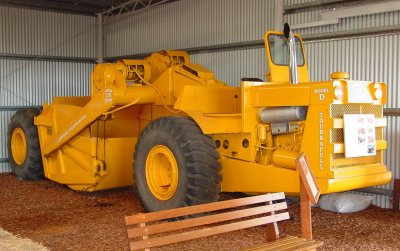
DARD-LeT-ModelD.jpgA late model, LeTourneau-Westinghouse, Model "D" Tournapull scraper. This machine is fitted with a 4 cylinder GM 2 stroke engine, a 5 speed "crash" gearbox, and has a big electric generator behind the engine, which produces electricity for the electric motors that power the steering, the lift motors on the bowl and apron, and the tailgate motor. These things are a handful to drive, and I know all about them, because I've actually got a licence to drive one! These machines need the main engine run at full RPM, or near it, to keep up the voltage to the electric motors. Otherwise, you run out of steering or power to load or empty the bowl. Early models were often known as "widowmakers" due to their tendency to kill operators who weren't properly trained on them. If you commenced a sharp turn and backed off the throttle - you couldn't straighten up, and they would sometimes roll over as a result. The early "D's" had multi-plate air disc brakes that would lock up all wheels at 40 mph, fully loaded. These brakes were incredible. However, when Westinghouse bought the LeTourneau Co in 1953, they commenced to put Westinghouse Air-operated drum brakes on the Model "D's", saying that the material used in the original LeTourneau disc brakes was too deadly to continue using. |
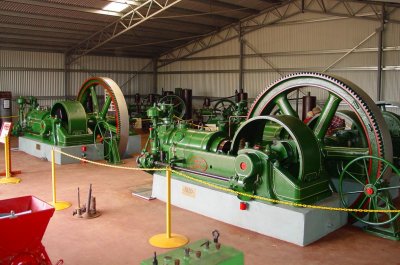
DARD-Tangye.jpgThe "Tangye" engine shed. The shed is full of mainly "Tangye" engines, restored by brothers Ron and Fred Smith. One of the Smith brothers is in the picture - the very old man with white hair and his back to the camera. This old fella must have been about 90 years old - he is sitting in his wheeled walker, while another bloke talks to him. In a far corner was his electric wheelchair. I guess it's his love of restoring old engines that keeps him going. |
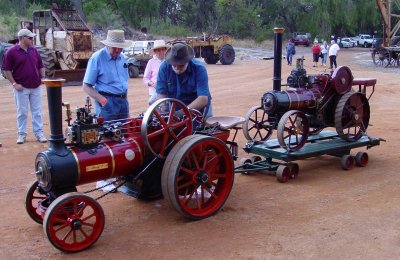
DARD-Steam models.jpgAn old fella with his two scale model steam engines. The one in front, took him 13 years to build. I didn't ask about the one on the trailer! I was fascinated by the rubber "tyres" on the models. He uses the rubber sheeting they normally use to recondition conveyor drive rollers. It's glued on to the steel wheels, with some kind of high strength adhesive. |
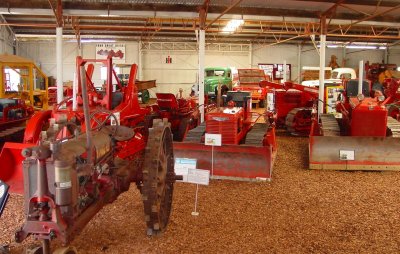
DARD-IH-collection-shed.jpgPart of the International collection in the International Shed, showing a range of IH crawlers, trucks, a Scout, and a Wheeltractor. |
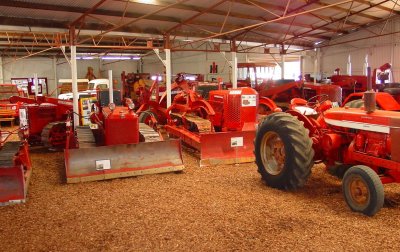
DARD-IH-collection-shed-2.jpgAnother view of part of the impressive collection of IH wheeltractors, crawlers, and IH trucks in the IH shed. |











